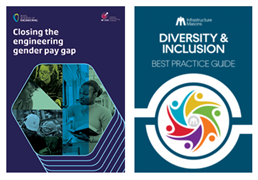Promoting Diversity and Inclusion in your industry is vital. After all, changing the culture in one organisation isn’t going to change the culture across the industry. So, it’s no wonder many of you are active beyond your own organisation.
A more inclusive image will help attract as many people as possible, which will help the entire industry. Initiatives that we – as Voice At The Table – consider to encourage diversity and inclusion across the industry – include: award schemes, industry data and league tables, industry pledges, accreditation, grants and bursaries, internship schemes, mentoring schemes, programmes in schools and higher education, awareness campaigns with events and talks and round tables. Oh, and Best Practice Guides.
If you’re contemplating a Best Practice Guide for your sector or your organizations’ members, the questions below will help you gain clarity on how to go about it.
When do you need a Best Practice Guide for promoting Diversity and Inclusion in your industry?
Best Practice Guides are typically helpful when there is a real desire in the industry to move forward. You regularly hear from member organisations that they have tried to become more diverse and inclusive, but have failed. When the reason for the lack of progress is not knowing how to do it (rather than why to do it), Best Practice Guides can be a powerful resource. But they are less helpful as a tool of persuasion, or to present a solid business case.
Why do you need an industry specific Best Practice Guide?
There are many good resources and best practice guides available in the public domain already. So you might be justified in wondering whether you need to create something specific to your sector. Consider whether it would suffice to share or re-purpose guides that are already publicly available.
In many cases, however, we find that clients need something that caters specifically for their industry. They know that when members see others in the industry move ahead it will inspire action. But examples from other industries tend to be less persuasive.
What content do you need in a Best Practice Guide?
Promoting Diversity and Inclusion in your industry requires a number of different elements. A mix of theory and practical guidance in the form of tips and case examples tends to work best. But the ultimate proportions depend on the sector and client preferences: some choose more emphasis on theory, and others opt for more examples.
Preferences often depend on practicalities. For instance, case studies/examples require a thorough knowledge of what’s happening in the industry and a good network, and less expertise in Diversity and Inclusion. They can be pulled together by a team of members, guided by an expert. Theory and practical guidance, however, are easier to put together by a diversity and inclusion expert and take less time to gather.
Examples of expert guidance content include the following:
- What is inclusion and diversity? Defining terminology
- Why is inclusion and diversity important in this industry? Linking to industry specific data.
- Steps to take to create an impactful diversity & inclusion programme; how to implement a programme; obtaining commitment; raising awareness; gathering data; measuring progress.
- Initiatives to create an inclusive employee life cycle and an inclusive culture.
What results can you expect when you using a Best Practice Guide for promoting Diversity and Inclusion in your industry?
A Best Practice Guide can give real guidance to those who are keen to move forward. A guide inspires organisations to take action, encourages those who have started to continue with more action and reassures them about what the right actions are. Overall, Best Practice Guides tend to increase implementation rates of diversity and inclusion in the industry.
In addition, publication of a guide gives a clear message that Diversity and Inclusion is important in the industry.
One way we recommend gauging industry interest in Diversity and Inclusion and the success of your guide is to monitor the number of people coming to the launch event, and the number of downloads of the guide.
How to get most impact?
There’s no point in writing a guide no-one will use. So, when designing and writing the guide, it is important to involve as many people in the industry as possible. You could, for instance, use your networks to set up an advisory board or committee, then involve the committees in accessing a wide range of best practices.
When designing the guide, we recommend ensuring easy access to the material, with appealing formatting. Consider using infographics, flow charts, images and icons to make it easy for people to find, download or order the guide.
Make the publishing of the guide a fanfare event, so that it gets a lot of attention. Present it at a well-attended event and involve influential people in the industry: ask them to be part of a panel discussion or provide an endorsement or testimonial.
Finally, realise that a guide is a living document. Find ways to add more recent case studies, consider annual updates or create a best practice community.
For more information, take a look at some Best Practice Guides with which we were involved.
Diversity & Inclusion Best Practice Guide for the Global Data Infrastructure Industry
Race and Gender Best Practice Guide for the UK Offshore Wind Industry
If you would like help promoting Diversity and Inclusion in your industry, get in touch to discuss options.


